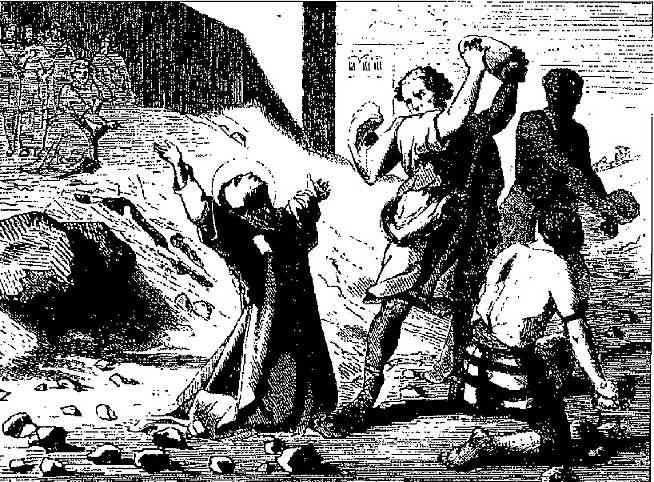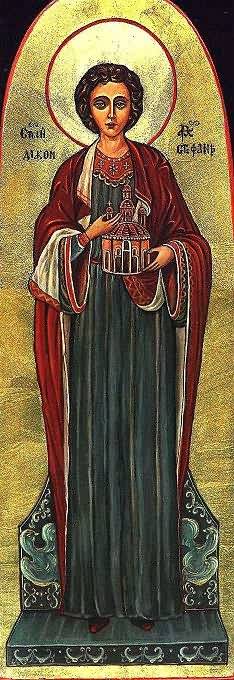|
English/Scandinavian
Christmas Legends:
S.
was a servant (variant: stable boy) at the court of King Herod. - S. sees
the star of Bethlehem and interprets the event to Herod. - At a banquet, a
roast cock gets up from the plate and crows "Christusnatus est".77.
- Enraged, Herod has S. stoned. - Selection of posthumous legends from
the Golden Legend: in the year 415, Gamaliel appears to Lucian the priest
and reveals the lost grave of S. - A sick pagan in the town of Martialis,
who has spent the night on flowers from the St S. altar, asks to be
baptized next morning.

Patronage:
the diocese of Vienna, patron saint of horses, stable boys, coopers,
coachmen, masons, slings men, tailors, stone carvers, weavers, carpenters;
against headaches, stitch, and stones.
Veneration
and cult sites: Body
allegedly found on 3rd Aug, 415 in Kafar Gamala, 15 km from Jerusalem (in
1916, the ruins of a small church with a rock tomb were discovered by
the Salesians, which might well be the grave mentioned by Lucian).
Translation of relics to the church on Mt Zion, Jerusalem, to
Constantinople; 560 relics to San Lorenzo fuori le mura, Rome, Zwiefalten
since 1141 (left hand). Since the 5C, a place 350m north of the Damascus
Gate in Jerusalem is mentioned as the martyrdom spot; a church was erected
there in 455/60 by the Empress Eudocia, later burnt down by the Persians
in the 7C (excavated 1882 when the Ecole Bib-lique was constructed). Canon
saints; veneration spread along two routes from the east:
a)
Ancona, Naples, north Africa, Rhone estuary, Aries, Konstanz; b) north
Italy, Chur, Passau, Vienna. In the late Middle Ages the cult of S. was
promoted chiefly by royal houses, esp. by King Stephen of Hungary.
Superstitions:
invocations in numerous incantations and traditions. - In Silesia and
Poland, after the service on St S.'s Day the priest is showered with oats
as he leaves the church; in Beuthen, the congregation indulge in mutual
throwing, probably in imitation of the stoning of S. - Early in the
morning, girls7 backs are beaten by the boys with switches or
sometimes (e.g. in Bohemia) with plants. - Sometimes this happens the
other way round or mutually, in the sense of a fertility rite. - The
last person to get up in Viol/ Schleswig on St S/s Day has to ride round
to the neighbors on a pitchfork in a nightshirt amid general mockery, and
is rewarded with a tasty morsel or two. - On the first day of school, the
prayer of St S. is read to boys to make them eloquent. - St Stephen's
potion has been around since Carolingian times, and is thus the earliest
demonstrable love potion. St S.'s wine, which is blessed in church, must
be red wine, and there must be a stone at the bottom of the glass. - In
Wurt-temberg, the poor used to get St S.'s bread for alms. -
Flowers, which are put on the St S.’s altar, brought health to the sick.
- Cloths from the St S's altar have curative effects. -Peasants on food,
barns and fields against witches and evil spirits sprinkle water dedicated
on St S.’s Day. - Salt consecrated on St S.'s Day is shaped into a block
and hung in the stall. - Before the cattle are driven up to the high
pastures in the New Year, they are given the salt to lick. - Peasants are
supposed to lick St S.'s salt if they go on a long journey. - Game
that licks St S.'s salt is easily caught by hunters. - Oats are
consecrated on St S.'s day, and are given to horses as a protection
against disease. - Bloodletting of horses on St S.'s day protects them
from disease. - There is in addition a rich tradition of customs at
Christmas and New Year not directly connected with S., such as the moving
of objects or traditions of horseshoes as harbingers of good luck in the
New Year, etc.
Representations
in Art: Apparel:
as a young deacon on a white tunic (S Lorenzo fuori le mura, Rome, 6C
mosaic); as a deacon in an amice/, alb, stole, maniple and dalmatic (chapel
of Merton College, Oxford, stained glass c. 1300); in a richly patterned
dalmatic (Ra-sini Collection, Milan, early 16C painting by V. Foppa);
dalmatic with a stole worn over the robe (Stadtischer Kunstbesitz, Goslar,
late 13C). Attributes: gospel book, palm (Hessisches Landesmuseum,
Darmstadt, mid- 13C painting); stones in a halo (S Ceci-lia in Trastevere,
Rome, fresco by Cavallini c. 1293); stones on his head (book of hours by
Rohan in Bibl. Nationale, Paris, lat. 947, illumination, 1st half of 15C);
stones in his hands (Bamberg Cathedral, Adam door, 13C fig.); stones on
the book (Breisach, Munster, fig. by H. L. Master 1526); in the folds of a
puffed dalmatic (Ghent altar, St Bavo, Ghent, painting by H. and J. van
Eyck 1432);
censer
(Kansas Gallery of Art, early 16C painting by Carpaccio); incense boat
(Museo Piersanti, Matelica, 15C painting by J. Bellini), elevated gospel
(cloister of St-Trophime, Aries, relief fr. 2nd half of 12C). Special
scenes: miracle of the wine in the house of S.'s parents
(St-Etienne, Beauvais, stained glass 1526); tomb (Musee municipal, Arras,
painting by E. Delacroix 1862). Martyrdom: S. lying beneath a
pile of stones (fragment of book cover fr. Metz School, c. 850); kneeling
S. being stoned (Louvre, Paris, painting by Carracci c. 1604); S. receives
the martyr's crown and palm from angels (National Gallery of Scotland,
Edinburgh, painting by A. Elsheimer c. 1602/5). Cycles: very numerous
: a) story as per Acts of Apostles: Chart-res Cathedra, south transept,
early 13C fig.; shrine at Gimel, late 12C reliefs; Nicholas V Chapel,
Vatican City, frescoes by Fra Angelico c. 1449; Szt Istvan church, Papa,
painting by F. A. Maulpertsch 1782; b) legends and biblical scenes: Sens
Cathedral, reliefs post 1268; Musee de Cluny, Paris, tapestries 1502; c)
finding of relics and translation Cycles: Vatican City museums,
14C painting by B. Daddi; S Lorenzo fuori le mura, Rome, mural, 2nd half
of 13C; d) Vita fabulosa version : Lentate Oratory, frescoes fr. 2nd
half of 14C with 43 scenes; e) English-Scandinavian version of Christmas
Legends: ceiling painting/ Dadesjo (Sweden), end 13C; St George's Chapel
Windsor, painting end 15C.
|

